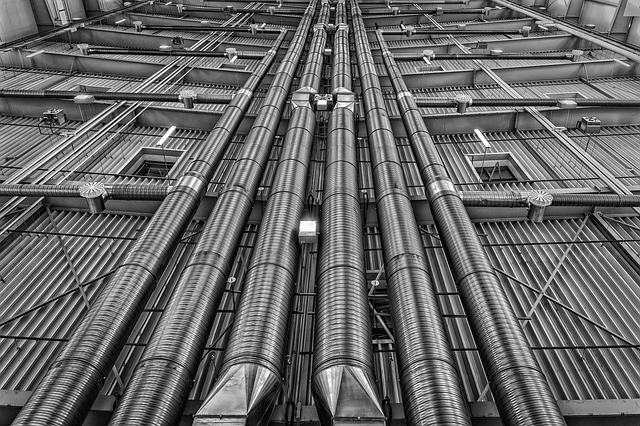Industrial air doors are pivotal in modern building automation, providing climate control, security, and efficiency across sectors like manufacturing and warehousing. Integrating with automated systems, these doors offer large opening air curtains for temperature-controlled access and energy-efficient HVAC barriers, promoting sustainable practices. Seamless connectivity and optimal performance rely on compatibility assessments between door systems and automation software. By leveraging smart sensors and data analysis, integrated industrial air doors enable precise climate control, real-time adjustments, and significant energy cost savings, transforming industrial spaces into eco-friendly environments. This technology is crucial for achieving net-zero buildings, especially in cold storage and manufacturing sectors with demanding protection requirements.
Industrial air doors are transforming the way buildings operate, offering a key component in modern building automation systems. These doors control airflow, temperature, and energy loss, playing a crucial role in enhancing indoor comfort, improving air quality, and reducing energy costs. This article delves into their functionality, explores the technical integration with automated systems, highlights cost savings, and discusses future trends, shedding light on why industrial air doors are a game-changer in sustainable building practices.
- Understanding Industrial Air Doors: Their Role and Benefits in Building Automation
- Integrating Air Doors with Building Automation Systems: Technical Considerations
- Advantages of Seamless Integration for Efficiency and Cost Savings
- Future Trends: Smart Air Doors and their Impact on Sustainable Buildings
Understanding Industrial Air Doors: Their Role and Benefits in Building Automation

Industrial air doors play a pivotal role in modern building automation systems, offering an array of benefits that enhance efficiency and safety across various industrial sectors. These doors are designed to control the flow of air, people, and materials within a facility, acting as both entrance barriers and heavy-duty manufacturing door systems. By integrating with automated processes, they ensure seamless operations and optimal environmental conditions.
From warehouse opening protection to factory entrance solutions, these doors provide efficient industrial climate separation, managing temperature and humidity levels. In settings like cold storage facilities, large opening air curtains ensure products remain at the right conditions while allowing for easy access. Furthermore, industrial HVAC barriers installed with automation can significantly improve energy efficiency, making them a smart choice for sustainable building practices.
Integrating Air Doors with Building Automation Systems: Technical Considerations

Integrating industrial air doors with building automation systems offers a multitude of benefits for efficient and smart facility management. This process involves technical considerations to ensure seamless connectivity and performance. When setting up such an integration, facility managers must assess the compatibility of both the door system and the automation software.
Air doors, particularly heavy-duty models designed for industrial applications, should be equipped with advanced communication protocols to interface with building automation networks. These doors act as dynamic components in the overall building ecosystem, providing solutions like warehouse opening protection, industrial climate separation, and efficient loading dock barriers. By integrating them with HVAC systems, they can optimize air circulation, reduce energy consumption, and enhance overall factory entrance solutions. Consider the door’s size, functionality (e.g., cold storage air doors or large opening air curtains), and environmental rating when selecting the right system for your manufacturing door needs.
Advantages of Seamless Integration for Efficiency and Cost Savings

Seamless integration of industrial air doors with building automation systems offers significant advantages in terms of both efficiency and cost savings. By connecting these advanced door systems to a centralized control mechanism, facilities can achieve precise climate control and optimize energy use across their entire operation. Smart sensors and automated controls enable real-time adjustments based on occupancy, temperature, and humidity levels, ensuring optimal environmental conditions without unnecessary energy expenditure.
This integration goes beyond mere convenience; it transforms industrial spaces into highly efficient environments. For instance, in a manufacturing facility, heavy-duty air doors can be programmed to open only when specific tasks require them, preventing energy loss during production lulls. Warehouse opening protection systems, such as large opening air curtains and loading dock barriers, can maintain ideal temperatures in storage areas, reducing the need for excessive cooling or heating. This not only minimizes operational costs but also contributes to a more sustainable and environmentally friendly industrial landscape.
Future Trends: Smart Air Doors and their Impact on Sustainable Buildings

The future of industrial buildings is poised for a significant transformation with the integration of smart air doors into building automation systems. These innovative solutions go beyond simple access control, integrating advanced sensors and connectivity to optimize energy efficiency, enhance security, and improve overall building performance. By leveraging data from these intelligent doors, facilities managers can achieve precise climate control, reducing energy consumption and carbon footprint, especially in large industrial spaces with extensive warehouse opening protection requirements.
As the demand for sustainable practices grows, smart air doors will play a pivotal role in achieving net-zero buildings. Their ability to adjust dynamically based on occupancy, temperature, and humidity ensures optimal ventilation while minimizing heat transfer. This technology is particularly beneficial for cold storage facilities, manufacturing plants, and loading docks where efficient climate separation is crucial. With the right industrial HVAC barriers in place, these smart doors can contribute to significant energy savings, making them a game-changer in the quest for greener, more sustainable industrial environments.
Industrial air doors, by seamlessly integrating with building automation systems, offer a powerful solution for enhancing energy efficiency and reducing operational costs. As the demand for sustainable buildings grows, these smart doors are poised to revolutionize the way we manage indoor environments. By leveraging advanced technologies, future trends suggest that industrial air doors will play an even more integral role in creating dynamic, responsive, and eco-friendly spaces.






